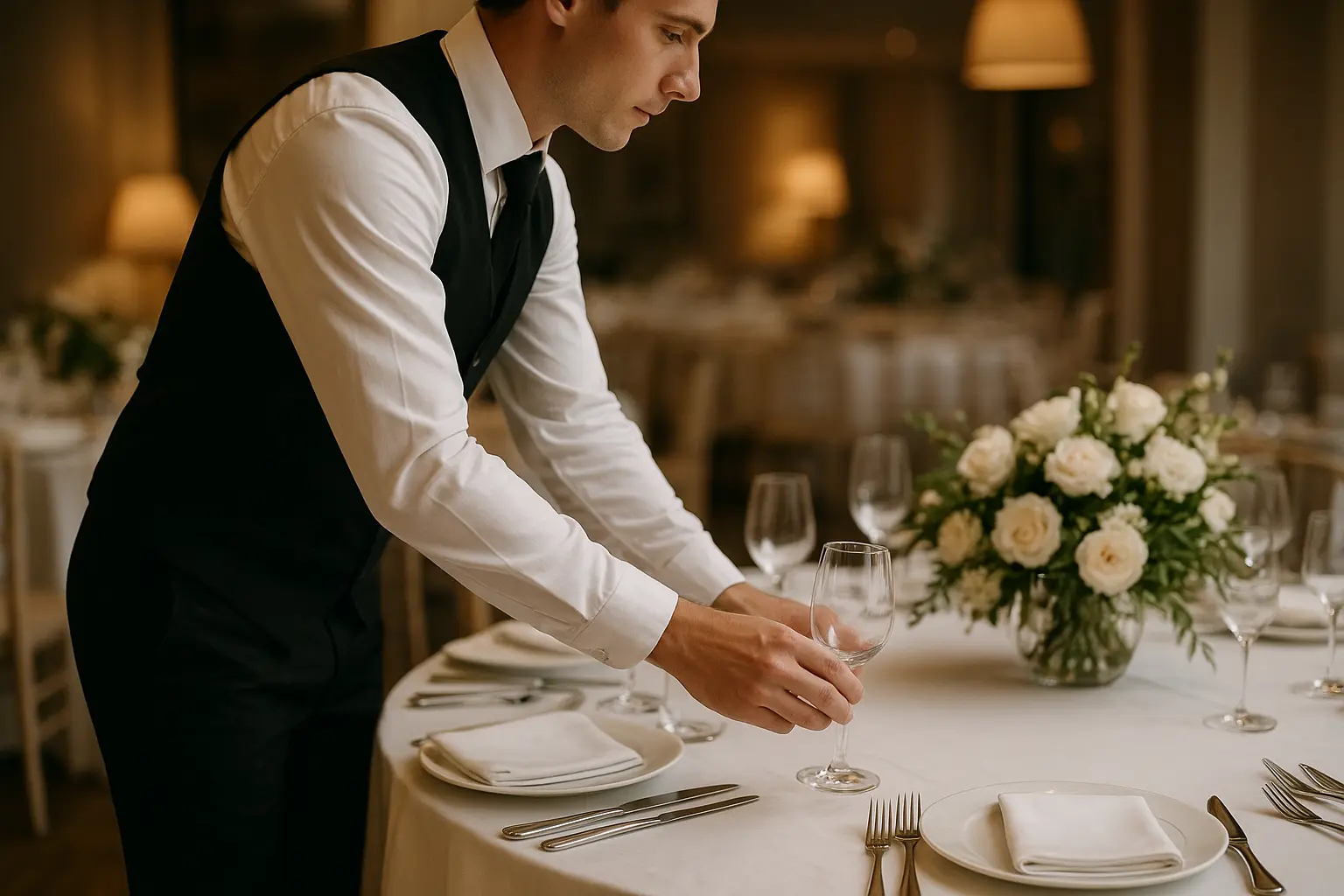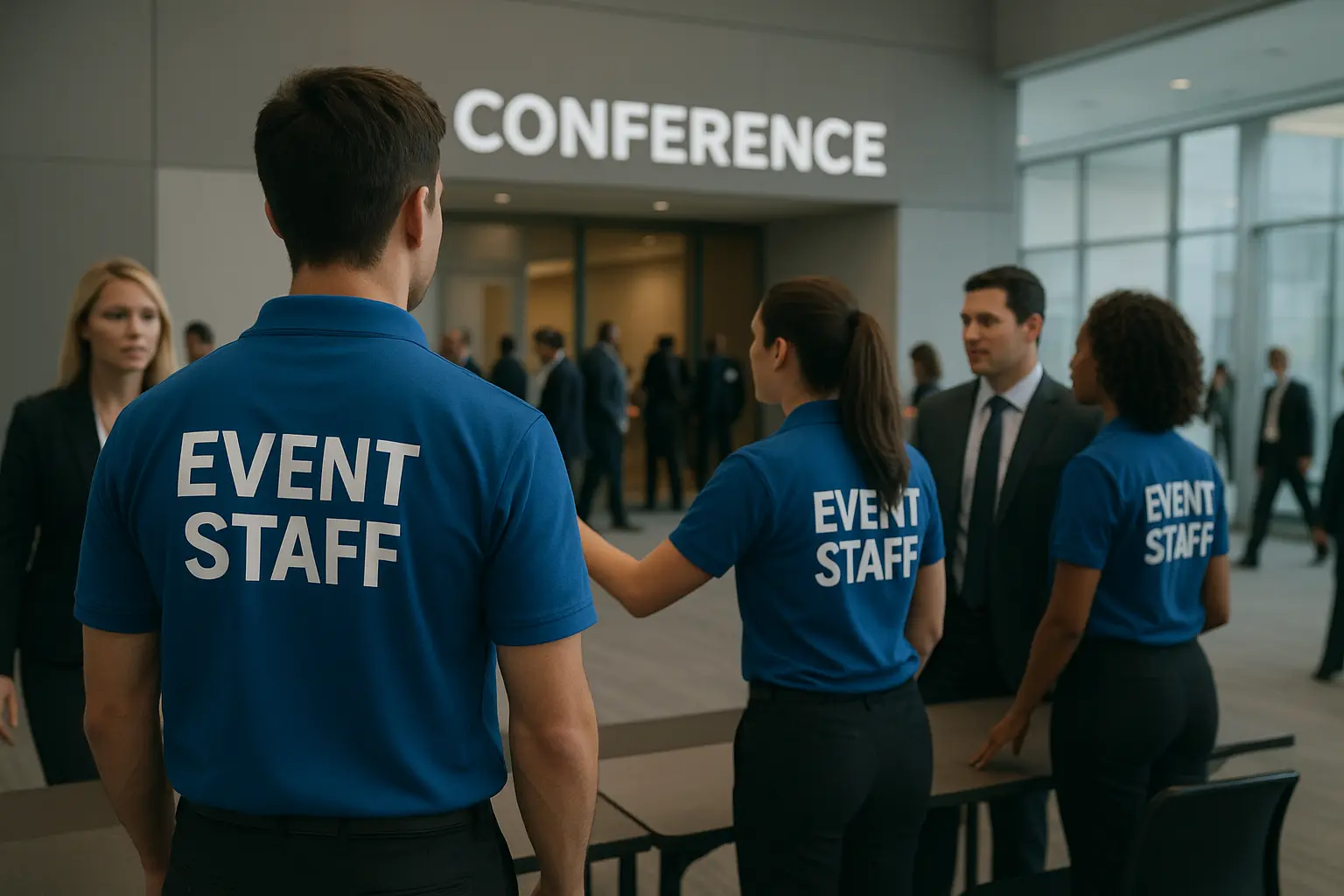CEO Excerpt
"A wedding's success isn't in the decor; it's in the flow. A poor staff to guest ratio wedding creates chaos. We build a precise plan, including the hidden support roles, that ensures every guest feels cared for, turning your investment into a flawless memory." – CEO, Event Staff
The ideal staff to guest ratio wedding planners use is 1 staff member per 10–15 guests.
However, this is a blended average. The real ratio depends entirely on your service style. A high-touch plated dinner requires a much tighter ratio (closer to 1:10) than a casual buffet (closer to 1:20).
What planners know, the "secret", is that a poor staff to guest ratio wedding is the single most common cause of event failure. It is the invisible variable that leads to cold food, long bar lines, a messy ballroom, and a chaotic guest experience.
Here are the quick reference ratios:
- Plated Dinner: 1 server per 10–12 guests (or 1 per 8 for ultra-luxury).
- Buffet Dinner: 1 server per 18–20 guests.
- Cocktail-Style Reception: 1 server per 25 guests.
Understanding these differences is the key to building a realistic staffing plan.
Executive Summary
The ideal staff to guest ratio wedding planners use is 1 server per 12 guests for plated dinners and 1 bartender per 50 guests for a simple bar. This guide provides the exact ratios and hidden support roles (like bussers and supervisors) needed for a flawless event.
How Many Servers Do You Need for a Wedding Reception?
For a standard plated dinner, the benchmark for how many servers for wedding receptions is 1 server per 10–12 guests (or roughly one per table).
Why this specific number? This ratio allows for "team service," where one server can drop off plates while their partner follows immediately with wine or water service. This precision in wedding food flow is what ensures all guests at a single table are served within moments of each other, preventing the awkward situation where one guest is finished before another has even received their main course.
Adjusting for Service Type
- Plated (1:12): This is the most labor-intensive and requires a large team of professional Waitstaff.
- Buffet (1:20): The question of how many servers for wedding buffets is different. The servers' role shifts from plating to aggressively clearing tables, refilling water glasses, and assisting elderly or infirm guests at the buffet line.
- Family-Style (1:15): This requires a tighter ratio than a buffet to manage, clear, and replenish multiple heavy platters for each table.
Other Variables That Change the Count
- Venue Layout: A kitchen located far from the main dining room (e.g., in a separate building or on a different floor) may require 1-2 extra servers just to act as runners.
- Number of Courses: A complex 5-course meal requires more staff than a 3-course meal for the added clearing, crumbing, and pacing.
Calculating how many servers for wedding events is a critical task for a smooth reception.
How Many Bartenders per Guest for a Wedding?
The standard benchmark for how many bartenders per guest wedding planners use is 1 bartender per 50 guests.
However, this comes with a major caveat: that 1:50 ratio is only for a simple "beer and wine" bar. The moment you introduce signature cocktails, the math changes completely.
Adjusting for Drink Complexity
- Beer & Wine Bar (1:75): With simple pours, a single bartender can handle a larger crowd efficiently.
- Full Cocktail Bar (1:35-50): This is the most critical ratio to get right. As VinePair notes, a complex, muddled cocktail can take 60-90 seconds to make, while pouring a beer takes 10. A 1:75 ratio at a cocktail bar will create a 20-minute line, which is the number one complaint from wedding guests. This is the professional answer to how many bartenders per guest wedding clients ask for.
- We provide professional Bartenders trained for high-volume, high-speed cocktail service.
The Barback: The Secret to a Fast Bar
For every 1-2 bartenders, you must add one Barback. This support role is the secret to a fast bar. They restock ice, glassware, garnishes, and liquor, so the bartender never has to leave their station to run to the back. A bar without a barback will inevitably fail during peak time.
The Hidden Roles Behind the Staff to Guest Ratio Wedding (Hospitality vs. Service)
What planners don't often tell you is that your staff to guest ratio wedding plan must cover more than just servers. A flawless event runs on two parallel teams: the Service Staff (who manage things) and the Hospitality Staff (who manage people).
Service Staff (The Operational Backbone)
- Bussers (1 per 3 servers): Event Servers & Bussers must work in teams. Bussers are essential for clearing tables quickly and silently so servers can focus on guests.
- Barbacks (1 per 2 bartenders): The barback is the engine of the bar. They ensure the Bar Production never stops.
- Kitchen/Runner Team (1-2 staff): A dedicated team that only moves food from the kitchen to a service staging area, keeping servers on the floor.
Hospitality Staff (The Guest-Facing Team)
- Greeters & Ushers: (1 per 50 guests) To welcome guests, hand out programs, and guide them from the ceremony to the cocktail hour.
- Hostesses: (1-2 total) To manage the guest list, seating chart, and gift table.
- Bridal Assistant (1 dedicated): A personal assistant for the wedding party, handling drinks, bustling the dress, and coordinating with the venue lead.
A luxury staff to guest ratio wedding plan invests heavily in these "hidden" hospitality roles, as they are how staff elevate experience.
How Venue and Timeline Impact Your Staff to Guest Ratio Wedding
The numbers above are a baseline. What planners know is that your venue layout and timeline can and will change them.
The Setup and Teardown Fallacy
Your staff to guest ratio wedding budget must include "hidden hours." A 6-hour reception does not mean a 6-hour workday.
- Setup: Budget 2-3 hours for every 100 guests. Staff will be polishing hundreds of glasses, meticulously folding napkins, setting tables to a precise diagram, and stocking bars long before guests arrive.
- Teardown: Budget 1-2 hours per 100 guests for a full breakdown, cleanup, and inventory.
This requires a full Production Teams mindset, not just a service mindset, and must be factored into your budget.
Operational Deep Dive: The "Kitchen-to-Table Travel Time"
- Ballroom: A kitchen attached to the ballroom has a short travel time. The 1:12 server ratio holds.
- Outdoor Tent / Sprawling Estate: This is a major cost variable. If the catering tent is 100 yards from the main dining tent, a server's "travel time" per table increases by 3-4 minutes. The food gets cold, and the service pace collapses.
- The Fix: You must add 10-15% more staff (or 1-2 dedicated runners) just to maintain the same service pace and ensure food arrives hot. This is a critical part of any event safety plan.
As leading publications like Brides agree, asking your venue exactly what staff they provide versus what you must hire is a key first step.
The Real-World Impact of Ratios (Luxury vs. DIY)
This is what you are actually paying for. The staff to guest ratio wedding directly determines the guest experience.
DIY-Level (1:20+ Ratio)
The Experience: Guests will wait 15 minutes at the bar. Tables will be cluttered with empty glasses from the cocktail hour. The reception will feel "under-managed" and chaotic. This is the most common of all event planning mistakes.
Standard-Level (1:12 Ratio)
The Experience: Service is efficient. Food arrives hot. Bar lines are manageable. This is the professional standard and what any good staff to guest ratio wedding plan aims for.
Luxury-Level (1:8 Ratio)
The Experience: Service is proactive. Guests' water glasses are never empty. Staff anticipate needs before they are requested. A supervisor maintains a live communication loop for immediate corrections. This level of large-scale logistics is what high-end brands and clients expect.
Conclusion: A Clear Plan for a Flawless Event
The staff to guest ratio wedding is your single most reliable factor for a seamless guest experience. This is not the place to cut corners. A clear staffing plan, based on the metrics in this guide and backed by data, is your best insurance policy for a perfect day. This is the difference a professional staff to guest ratio wedding plan makes, and you can get an instant quote to build a team that ensures flawless service.



.webp)

